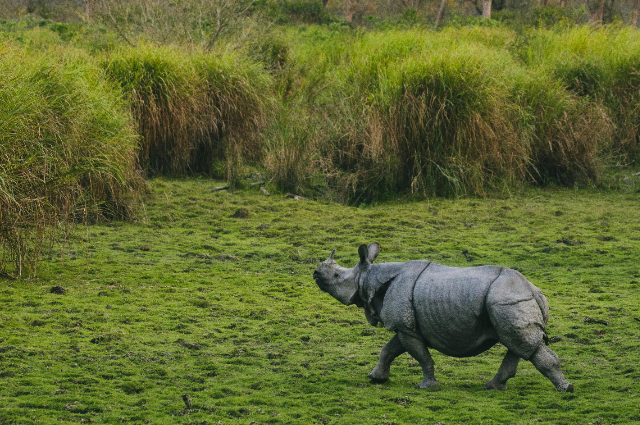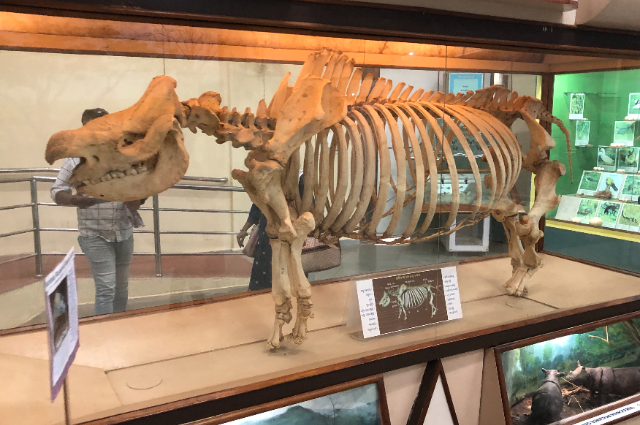
A rhinoceros, often referred to as a "rhino," is a large, herbivorous mammal characterized by its thick, protective skin and one or more horns on its snout. Rhinos belong to the family Rhinocerotidae and are known for their massive size and distinctive appearance.
There are five species of rhinoceros:
- White Rhinoceros (Ceratotherium simum): Despite their name, white rhinos are not actually white but rather gray. They have a wide mouth adapted for grazing on grasses and are the largest species of rhino.
- Black Rhinoceros (Diceros bicornis): Black rhinos are smaller than white rhinos and have a pointed upper lip suited for browsing on leaves and branches. They are critically endangered due to habitat loss and poaching.
- Indian Rhinoceros (Rhinoceros unicornis): Also known as the greater one-horned rhinoceros, they are native to the Indian subcontinent and have a single horn. Their skin has numerous folds.
- Javan Rhinoceros (Rhinoceros sondaicus): The Javan rhino is one of the rarest and most endangered large mammals in the world. They are native to Southeast Asia and have a single horn.
- Sumatran Rhinoceros (Dicerorhinus sumatrensis): This is the smallest rhino species and is found in Southeast Asia. They have two horns and are covered in hair, making them unique among rhinos.
Rhinoceroses are known for their horn, which is made of keratin, the same protein found in human hair and nails. Unfortunately, the demand for rhino horns in traditional Asian medicine and the illegal wildlife trade has led to poaching and a severe decline in rhino populations. Conservation efforts are in place to protect and preserve these magnificent creatures, including their ecosystem and habitat conservation, anti-poaching initiatives, and breeding programs in captivity.
What are the factors responsible for the global decline of rhinoceros populations?
The global decline of rhinoceros populations can be attributed to several interconnected factors, primarily driven by human activities:

- Poaching: Poaching for rhino horns is the most immediate and significant threat to rhino populations. Rhino horns are highly sought after in illegal wildlife markets, primarily in Asia, where they are believed to have medicinal properties and are used for ornamental purposes.
- Habitat Loss: Habitat destruction due to human activities, such as agriculture, logging, and infrastructure development, has reduced the available range for rhinos. This leads to habitat fragmentation and isolation of populations.
- Human-Wildlife Conflict: As human populations expand and encroach into rhino habitats, conflicts between humans and rhinos occur. Crop damage and occasional human fatalities due to rhino encounters can lead to retaliatory killings.
- Inadequate Law Enforcement: Weak law enforcement and corruption in some countries enable poachers to operate with impunity. Insufficient penalties for wildlife trafficking also contribute to the problem.
- Demand for Traditional Medicine: Rhino horns are erroneously believed to have medicinal properties in some traditional Asian medicine practices, even though they are made of keratin, the same substance as human hair and nails. The demand for horns in this context drives poaching.
- Lack of Awareness: Lack of awareness and education about the importance of rhinos in ecosystems and the consequences of poaching can result in apathy and insufficient public support for conservation efforts.
- Illegal Trade Networks: Organized crime networks are involved in the illegal trade of rhino horns, making it a challenging problem to combat. These networks often have international connections.
- Limited Genetic Diversity: Some rhino populations have become so small and isolated that they suffer from reduced genetic diversity, which can weaken their ability to adapt to changing environmental conditions.
Conservation organizations, governments, and international bodies are actively working to address these challenges. Efforts include anti-poaching patrols, habitat conservation, community engagement, and demand reduction campaigns aimed at changing consumer behavior. While progress has been made in some areas, the fight to protect rhinos and ensure their survival remains an ongoing global conservation priority.
What strategies need to be adopted to make successful rhino conservation action around the world?
Successful rhino conservation action around the world requires a multi-faceted approach involving various stakeholders. Here are key strategies that need to be adopted:
- Anti-Poaching Efforts: Strengthen anti-poaching units with well-trained personnel and adequate resources. Utilize modern technology, such as drones and camera traps, for monitoring and surveillance. Implement intelligence-led operations to disrupt poaching networks.
- Habitat Protection and Restoration: Establish and maintain protected areas and wildlife reserves with suitable rhino habitats. Restore and reconnect fragmented habitats through conservation corridors. Manage habitats to ensure they can support healthy rhino populations.
- Community Engagement: Involve local communities in conservation efforts and provide incentives for supporting rhino protection. Develop alternative livelihoods for communities living near rhino habitats. Promote education and awareness about the importance of rhino conservation.
- Law Enforcement and Legal Measures: Enforce strict penalties for wildlife trafficking and poaching. Improve legislation related to wildlife protection and enforce international agreements. Collaborate with law enforcement agencies at regional and international levels.
- Demand Reduction: Conduct public awareness campaigns in consumer countries to reduce demand for rhino horn. Engage with traditional medicine practitioners to promote alternatives to rhino horn. Encourage governments to enforce bans on rhino horn trade.
- Translocation and Genetic Management: Implement translocation programs to establish or augment populations in suitable habitats. Monitor and manage genetic diversity within rhino populations to maintain healthy gene pools.
- Research and Monitoring: Continuously monitor rhino populations and their health. Conduct research on rhino behaviour, genetics, and disease to inform conservation strategies.
- International Cooperation: Collaborate with other countries and international organizations to combat wildlife trafficking. Share information and best practices for rhino conservation on a global scale.
- Sustainable Tourism: Promote eco-tourism as a means to generate income for local communities and fund conservation efforts. Ensure that tourism activities are well-managed to minimize disturbance to rhinos.
- Capacity Building: Train and equip local rangers, conservationists, and law enforcement personnel. Build the capacity of local institutions and organizations involved in rhino conservation.
- Political Will and Funding: Garner political support and commitment at national and international levels for rhino conservation. Allocate sufficient funding to support conservation efforts effectively.
- Adaptive Management: Be flexible and adaptive in conservation strategies, taking into account changing circumstances and emerging threats.
Rhino conservation is a complex and ongoing challenge, but with concerted efforts from governments, conservation organizations, local communities, and the public, it is possible to secure the future of these iconic and endangered species.
